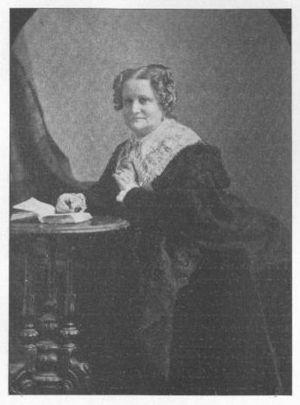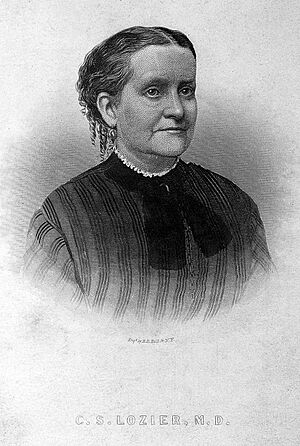Clemence Sophia Harned Lozier facts for kids
Quick facts for kids
Clemence Sophia Harned Lozier
|
|
|---|---|
 |
|
| Born |
Clemence Harned
December 11, 1813 |
| Died | April 26, 1888 (aged 74) New York City
|
| Resting place | Green-Wood Cemetery, Brooklyn |
| Alma mater | Syracuse Medical College (1853) |
| Spouse(s) | Abraham Witton Lozier (c. 1829 — died 1837), John Baker (1844 — divorced 1861) |
| Children | Abraham Witton Lozier Jr. |
| Scientific career | |
| Fields | Homeopathy, surgery, gynecology |
| Notable students | Anna Manning Comfort (niece) |
Clemence Sophia Harned Lozier (born December 11, 1813 – died April 26, 1888) was an American doctor. She started the New York Medical College and Hospital for Women. Dr. Lozier was also a strong supporter of women's rights and an activist. She led groups like the New York City Suffrage League and the National Women's Suffrage Association.
Contents
Early Life and Learning
Clemence Sophia Harned was born in Plainfield, New Jersey. Her birthday was December 11, 1813. Her parents were David Harned and Hannah Walker Harned. Her mother learned a lot about medicine from Native American tribes. This helped her care for sick people in their town. Clemence saw her mother treating people from a young age. She was the youngest of 13 children.
When she was 11, both her parents had passed away. She then lived with relatives and finished school at Plainfield Academy. At 17, she married Abraham Witton Lozier, who was an architect. Her family had strong religious beliefs, which guided her throughout her life.
Teaching and Early Medical Interest
When her husband became ill, Clemence started studying the human body. At 19, she began teaching classes from her home. She taught girls about anatomy, how the body works, and staying healthy. She taught up to 60 students each year for 11 years. Her students came from important families, which helped her become a respected teacher.
She learned about health and anatomy from her older brother, who was a doctor. He also helped her interest in medicine grow. Clemence was one of the first teachers to include these subjects in girls' education. At that time, these topics were not usually taught to women. Her classes quickly became very popular. She taught women about how fashion, like tight corsets, could harm their bodies. She continued teaching until 1843.
Soon after, she moved to New York City. She kept giving lectures and visiting sick people. Her first husband died in 1837. She later married John Baker in New York, but their marriage ended. After her first husband's death, Lozier wanted to focus fully on her medical training.
Becoming a Doctor
Clemence Lozier learned a lot about medicine from her mother and brother. She also gained experience by caring for her sick husband. She wanted to go to medical school, but women were not usually accepted back then. Her brother continued to teach her. She applied to many medical schools but was often turned down. Even Elizabeth Blackwell, another famous female doctor, faced similar challenges.
Breaking Barriers in Medical Education
Finally, in 1849, Clemence was allowed to attend classes at Central New York College of Rochester. Later, she was accepted into Syracuse Eclectic College. This college agreed to let her study medicine. She graduated at the top of her class in 1853.
After graduating, she became a big supporter of homeopathic medicine. This was a new way of treating illnesses. From 1853, women could finally go to a hospital and be treated by a female doctor like Clemence.
In 1860, she started giving lectures in her own home. These talks led to the creation of a "Medical Library Association." This group aimed to encourage women to read about female anatomy and health.
Clemence's Medical Career
Before becoming a doctor, Clemence Lozier had seen many serious illnesses, especially among women and children. She had performed many surgeries to remove growths. People often asked for her advice when they were sick.
After medical school, Dr. Lozier opened her own practice. She focused on homeopathic treatments. She specialized in obstetrics (helping with childbirth) and gynecology (women's health). She was also known for her surgical skills. Her practice became very successful. She believed that women were naturally good at being doctors. She especially thought more women should be obstetricians. She often saw over 50 patients a day, showing how much people wanted female doctors.
Founding a Medical College for Women
From 1860 to 1863, she taught private lectures at her home. This led to the creation of "A Ladies' Medical Association." More and more women wanted to learn medicine, but many were turned away from medical schools. Dr. Lozier worked with her friend Elizabeth Cady Stanton to ask the New York State government for permission to open a women's medical college.
In 1863, her dream came true. The New York Medical College and Hospital for Women opened. It was the first college of its kind. Seven female students joined the first class. Eight doctors taught them, four women and four men.
Clemence Lozier was the president of the college. She taught courses on diseases of women and children. For seven years, she used her own money to support the college. She even donated $10,000. After the Civil War, in 1867, Dr. Lozier traveled to Europe. She visited hospitals and talked with doctors there. When she returned, she continued teaching as the dean and professor of gynecology and obstetrics.
Later, investors encouraged her to make the college bigger. A large new building was bought. However, the investors pulled out, and Dr. Lozier lost all her money in 1878. Despite this, the college survived. She went back to practicing medicine. The Women's Medical College later became part of the New York Medical College in 1918.
Fighting for Change
Dr. Lozier cared deeply about improving people's lives. She did more than just treat patients. She held meetings for the Anti-Slavery Society at her home every month. During the July Riots of 1862, she gave shelter to African Americans. She also collected food and medicine for children from the Colored Orphan Asylum after it burned down.
Her son said her house was a meeting place for all kinds of reformers. It was filled with papers and pamphlets about women's rights, voting rights, and ending slavery. She also supported temperance (avoiding alcohol), health reforms, and better treatment for Native Americans.
Supporting Women's Rights
She helped start the Female Guardian Society with Margaret Pryor. This group visited prisons and poor areas in New York. They helped women and children who were being mistreated. For seven years, Lozier and Pryor visited the poor and abandoned. They often gave them medical advice when they were sick.
Clemence Lozier was a well-known suffragist, meaning she fought for women's right to vote. She was good friends with Elizabeth Cady Stanton. She also fought for her female students to attend classes with men at Bellevue Hospital College. She spoke at public meetings to change people's minds.
She also fought for women's rights in court. She successfully helped free Hester Vaughn, who had been wrongly accused of murder. When Susan B. Anthony was punished for voting, Dr. Lozier called a public meeting. She spoke out against the judge who sentenced her.
She was the president of many important groups. These included the Woman's American Temperance League and the Moral Education Society of New York. She also led the National Woman Suffrage Association for five years. From 1873 to 1886, she was president of the New York Woman's Suffrage Society.
Organizations Clemence Lozier Was Part Of
- Homeopathic County Society
- WCTU
- National Woman Suffrage Association
- NY Suffrage League
- City Ladies' Suffrage Committee
- Universal Peace Union
- NY Abolitionists' Reunion
- American Female Guardian Society
- Moral Education Society
Clemence Lozier's Legacy
Clemence Lozier founded the first medical college for women. She helped train over 200 female doctors. Her hospital treated over 2,000 female patients each year. It was the first place where a woman could be treated by a female doctor. This helped women gain more control over childbirth.
She had seven sons, but only one, Dr. Abraham W. Lozier Jr., survived. By the time she passed away, nine of her relatives had become doctors. This included her daughter-in-law, Charlotte Denman Lozier, who graduated from the college Clemence founded.
Dr. Lozier also helped make female doctors more respected. Elizabeth Cady Stanton said that other doctors tried to find fault with her. But "in spite of all the tricks of her enemies, she won."
Clemence Lozier was the first woman to present a scientific paper to the New York State Medical Society. This paved the way for other female scientists. She also pushed for physiology classes in schools. She taught about the importance of education in meetings and in her writings.
Because of Dr. Lozier, women in New York could finally study medicine. Before her, no schools in New York offered classes to women. She served as president and professor of women's diseases from 1863 to 1867. She was also dean and professor of gynecology from 1867 to 1888. She had her own private practice from 1853 to 1888.
One of her most famous writings was a short booklet called Child-Birth Made Easy. It gave mothers important knowledge. Dr. Lozier passed away from heart problems in 1888. This was two days after she gave the 25th graduation speech at the college she started.
See also
 In Spanish: Clemence Sophia Harned Lozier para niños
In Spanish: Clemence Sophia Harned Lozier para niños


